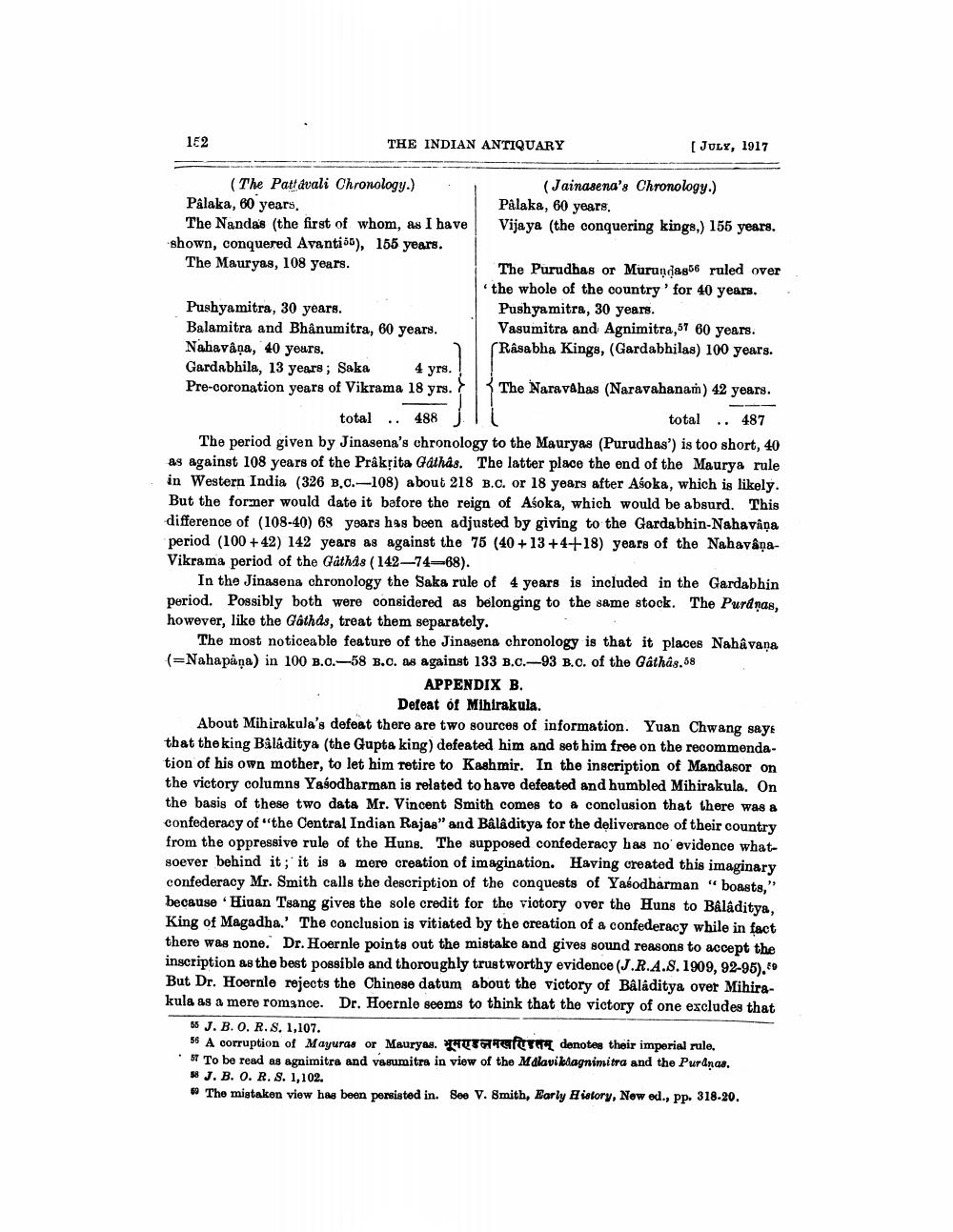________________
162
THE INDIAN ANTIQUARY
[July, 1917
(The Patt dvali Chronology.) .
(Jainasena's Chronology.) Palaka, 60 years,
Palaka, 60 years. The Nandas (the first of whom, as I have Vijaya (the conquering kings,) 155 years. shown, conquered Avantis.), 155 years. The Mauryas, 108 years.
The Purudhas or Muruņdag66 ruled over
the whole of the country' for 40 years. Pushyamitra, 30 years.
Pushyamitra, 30 years. Balamitra and Bhânumitra, 60 years. Vasumitra and Agnimitra, 57 60 years. Nahavâņa, 40 years.
Rasabha Kings, (Gardabhilas) 100 years. Gardabhila, 13 years; Saka 4 yrs. Pre-coronation years of Vikrama 18 yrs. The Naraváhas (Naravahanaṁ) 42 years. total .. 488 TL
total. 487 The period given by Jinasena's chronology to the Mauryas (Purudhas') is too short, 40 as against 108 years of the Prakrita Gathas. The latter place the end of the Maurya rule in Western India (326 B.C.-108) about 218 B.C. or 18 years after Asoka, which is likely. But the former would date it before the reign of Asoka, which would be absurd. This difference of (108-40) 68 years has been adjusted by giving to the Gardabhin-Nahaviņa period (100 +42) 142 years as against the 75 (40+13+4+18) years of the NahavânaVikrama period of the Gathas (142-74-68).
In the Jinasena chronology the Saka rule of 4 years is included in the Gardabhin period. Possibly both were considered as belonging to the same stock. The Purdnas. however, like the Gathds, treat them separately.
The most noticeable feature of the Jinasena chronology is that it places Nahậvana (=Nahapana) in 100 B.0.-58 B.C. as against 133 B.C.-93 B.C. of the Gathâs.68
APPENDIX B.
Defeat of Mihirakula. About Mihirakula's defeat there are two sources of information. Yuan Chwang saya that the king Baladitya (the Gupta king) defeated him and set him free on the recommendation of his own mother, to let him retire to Kashmir. In the inscription of Mandasor on the victory columns Yasodharman is related to have defeated and humbled Mihirakula. On the basis of these two data Mr. Vincent Smith comes to a conclusion that there was a confederacy of the Central Indian Rajas" and Bâlâditya for the deliverance of their country from the oppressive rule of the Huns. The supposed confederacy has no evidence whatsoever behind it; it is a mere creation of imagination. Having created this imaginary confederacy Mr. Smith calls the description of the conquests of Yasodharman boasts," because Hiuan Tsang gives the sole credit for the victory over the Huns to Baladitya, King of Magadba.' The conclusion is vitiated by the creation of a confederacy while in fact there was none. Dr. Hoernle points out the mistake and gives sound reasons to accept the inscription as the best possible and thoroughly trustworthy evidence (J.R.A.S. 1909, 92-95).49 But Dr. Hoernle rejects the Chinese datum about the victory of Baláditya over Mihirakula as a mere romance. Dr. Hoernle seems to think that the victory of one excludes that
55 J. B.O.R.S. 1,107. 56 A corruption of Mayuras or Mauryas. T o tefter denotes their imperial rule, 57 To be read as agnimitra and vasumitra in view of the Malaviklagnimitra and the Purdnas. 58 J. B. 0. R. S. 1,102.
Tho mistakon viow has been porsisted in. See V. Smith, Warly History, New ed., pp. 318.20.




